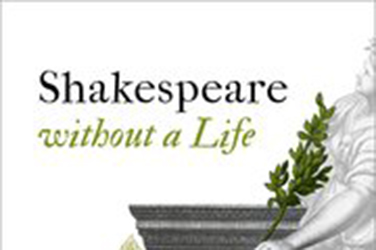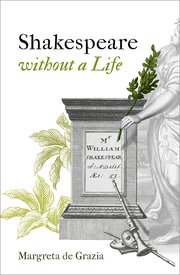
- Free Article: No
- Contents Category: Literary Studies
- Review Article: Yes
- Article Title: Endless fascination
- Article Subtitle: An innovative twist on Shakespeare biography
- Online Only: No
- Custom Highlight Text:
It is a rare year that goes by without the publication of yet another new biography of William Shakespeare in response to the seemingly insatiable desire for insights into the life and mind of the great writer. The proliferation of life studies isn’t exactly unwarranted: among the most exciting recent discoveries shedding light on how Shakespeare lived is Geoffrey Marsh’s pinpointing of the address at which Shakespeare lived in Saint Helen’s parish in 1598, and Glyn Parry and Catheryn Enis’s identification of numerous writs against John Shakespeare until as late as 1583, when Shakespeare was still a teenager.
- Featured Image (400px * 250px):

- Alt Tag (Featured Image): David McInnis reviews 'Shakespeare Without a Life' by Margreta de Grazia
- Book 1 Title: Shakespeare Without A Life
- Book 1 Biblio: Oxford University Press, £25 hb, 177 pp
- Book 1 Cover Small (400 x 600):

- Book 1 Cover (800 x 1200):

There is no account of Shakespeare’s life in the First Folio of 1623, which organised its contents by genre, not chronology; anecdotes about Shakespeare were in circulation during his lifetime and in the century that followed, and it was these (rather than documentary evidence) that formed the basis of Nicholas Rowe’s account of Shakespeare’s life in his 1709 edition of the plays, written ‘without continuity or development and no documents [to] substantiate the incidents it relates’. These anecdotes, de Grazia observes, have a ‘structural similarity’ in which Shakespeare misbehaves, repeatedly, and ‘each offence has some form of literary outcome’: caught poaching deer, he responds with a libellous ballad and relocates to London, where his career is launched; asked to write an acquaintance’s epitaph, he pens something bordering on blasphemy. By contrast, when the late-eighteenth-century Shakespeare scholar Edmond Malone set about writing the first modern biography of Shakespeare, based on archival records rather than anecdotes, and imposing a sense of continuity of narrative and development of man and career (a ‘Life’), the resulting account of Shakespeare leaves de Grazia posing the question: ‘why is the anecdotal Shakespeare at such variance from the Shakespeare of later narratives?’ Curiously, the anecdotal picture of Shakespeare aligns with the historical reception of his writing as unregulated, excessive, and extravagant, as Ben Jonson famously averred: ‘His Wit was in his own Power, would the Rule of it had been so too’.
As de Grazia’s study demonstrates so compellingly, when life writing shifted from the anecdotal to the documentary, we lost something of our appreciation of Shakespeare as critics tried to force square pegs into round holes. The anecdotes can’t be assimilated into a cohesive biography, for they lack development and chronology; but they are consistent in limning Shakespeare as ‘at best rude and brash, at worst criminal and sacrilegious’. Malone, who located more primary records pertaining to Shakespeare than anyone before or since, severed our connection to this older train of knowledge and supplanted it with his new attempt to make sense of the man and his work, through records. Concomitant with this alteration of life writing was the rise of the textual editor in the eighteenth century. Scholars like Samuel Johnson attempted to edit the textual witnesses of Shakespeare’s works (the early quartos and folios) to make them conform to some imagined, impossibly perfect state befitting Shakespeare, correcting metrical irregularities, standardising spellings and emending textual cruces, and imposing Classical act and scene divisions. Alongside this, de Grazia argues, literary criticism itself changed: ‘Criticism is not the application of rules to Shakespeare’s vagaries but rather the tracking of the development of his singular genius by its own self-determining criteria.’
Where the Folio had ordered Shakespeare’s plays by genre, elevating the status of drama and showcasing the virtuosity of the playwright, the later editors and biographers set about ordering Shakespeare’s works by date of ostensible composition: a principle that purportedly elucidated the development of Shakespeare’s genius. Prior to Romanticism, one had a genius for something; post-Romanticism, it was possible to instead be a genius. Shakespeare was a chief beneficiary of this categorical change in thinking, and Malone drove the change in Shakespeare studies with his attempt (in his 1821 edition) at ‘a dated continuum that runs through both what Shakespeare did and what he wrote’. A direct consequence of this chronological structure was the Victorian critic Edward Dowden’s introduction of the term ‘romance’ to describe Shakespeare’s late plays, with the effect that ‘[g]enres are now phases or “periods” of Shakespeare’s creative life’, and even the logic of the Folio’s genres is subsumed by the fetishisation of chronology and biography. There is an implied telos that sees the humble glove-maker’s son develop and mature into the greatest of English writers as he progressively masters each dramatic genre.
In her final chapters, de Grazia points out that although it was a novelty in the eighteenth century, the concept of an authorial archive – the survival of a writer’s drafts, letters, diaries, etc. – becomes not only naturalised but retrospectively imagined as equally normal in an earlier age (Shakespeare’s) that had not concerned itself with the preservation of such ephemera. Despite Malone’s valiant archival sleuthing, precious little documentary evidence pertaining to Shakespeare’s life turned up; nor was it ever likely to do so: Malone and his peers were anachronistically imposing their expectations on a different time. The result: ‘It was in the context of this impossible longing for Shakespeare’s absent firsthand materials that the 1609 Sonnets were first canonized’, for they alone of Shakespeare’s works present themselves as if written in his own voice, and this, de Grazia shows, was how they were critically edited for the first time in 1780.
Ironically, the Sonnets, despite their explicit investment in posterity as a literary trope, were not reprinted for a century, and were only gradually reintegrated into the Shakespeare canon. When Malone turned to them, it was, in hindsight, inevitably for ‘their unique promise of access to Shakespeare’s person’: a tradition inaugurated by Malone but which proved wildly influential. To appreciate how radical this was, de Grazia offers a detailed account of the publication history of the poetry to demonstrate that ‘[f]or almost a century and a half … Shakespeare’s Sonnets were read in a miscellany [format] that precluded autobiographical readings’ and that ‘detaches the Sonnets from their authorial source’ such that ‘they bear no personal trappings’. With the kind of breath-taking clarity that makes one chastise oneself for not having noticed before what she points out, de Grazia shrewdly observes that consistently throughout the 1623 Folio, the 1609 Sonnets, and the 1640 Poems, ‘the works are imagined surviving without the individuating particulars of their author’s life’ – which is precisely how they did survive for 200 years: Shakespeare without a life.


Comments powered by CComment